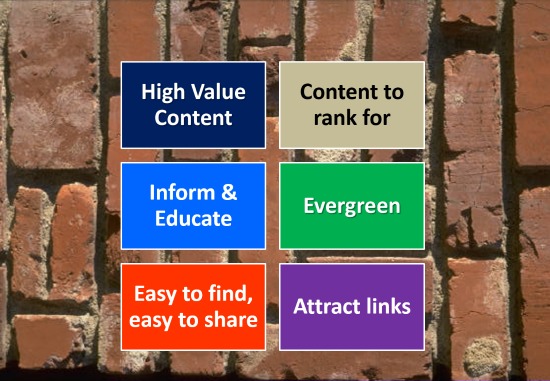Writing great blog posts doesn’t just happen. Very few people can sit down in front of their computer, start typing away, and POOF, out comes a valuable and engaging blog post.
Every blog post starts with a thought or an idea. Where does that idea come from? All kinds of places. For you, it might come from your daily reading. For me, it could come from some hot topics on my frequently visited forums. For someone else, a client email may trigger a big idea.
Regardless of where the idea comes from, unless you write it down (or start writing immediately), your idea may be lost to the edge of the outer rim of space where only the Serenity could pick up the transmission. Since space communication is limited at the moment, your blog is the best place for all those ideas rattling around in your brain. But those ideas will never see the light of your computer screen, let alone your blog, if you never document them in the first place.
This is where an editorial calendar comes into play. It lets you take all your ideas and map them out into a blogging game plan. Instead of just writing one blog post at a time and then rummaging to come up with an idea for the next one, an editorial calendar helps you blog more strategically. Most people tend to produce the same “style” of content over and over. When you put together an editorial calendar, it lets you strategize not just on what topics to write about, but what types of content to produce and when.
Face it. Doing the same thing over and over again, no matter how valuable, can get old for you and your readers. The best way to mix it up a bit is to make a plan that allows you to do just that.
You can start with these three different types of content:
1. Cornerstone Content

Every blog should have some cornerstone content. This is the content that anchors your blog and helps you become known as an authority in your industry. For some, this is the easiest type of content to produce; however, it can often be the most time-consuming as well. That’s because you usually can’t just hammer out a cornerstone piece of content. You have to develop it. While the knowledge might be there, you want to make sure it is expressed in a way that your target audience can consume, understand, and engage with. Here are some things your cornerstone content should be:
- High Value: Every piece of cornerstone content must meet this demand. If it’s not high value, then it just isn’t cornerstone. That’s not to say that it’s not good enough content for your blog, but when seeking to produce the type of content that anchors your site, its worth must be obvious.
- Optimized for Search Engine Rankings: If you’re going to take the time to produce cornerstone content, you might as well take a few extra minutes to find and use relevant, related keywords. After all, this is your wheelhouse! No sense producing content that won’t even rank for what you’re good at!
- Educational: Seek to educate and inform your audience in new ways. Don’t just write the same things searchers can find in other places. Instead, write with a unique perspective that will help your audience walk away having learned something they wouldn’t have from any other site.
- Evergreen: Evergreen content is that which withstands the test of time. Most current-event or newsworthy content has a short shelf life. While that can be a form of cornerstone content for your blog, most of your cornerstone content should be information that visitors will find valuable today, tomorrow, and even years from now. That’s tough to do in constantly evolving industries, which is what makes evergreen content even more valuable!
- Shareable: Make your content easy to share. Not just by having social sharing icons (though that’s a start), but by speaking in terms that are easily passed on in social channels. This often means using layman’s terms, writing easily digestible sentences, breaking up content with bullet points and headings, and including some “ah-ha” moments. All of these make content infinitely more shareable than it otherwise might have been—and they are all easy to do!
- Link-Worthy: “Shareable” and “linkable” are not the same thing. Sharing content is the low threshold. Getting people to link to your content is a bigger task because it means more work for the linking party. The best way to create linkable content is to write articles that can act as a resource for other people. As other writers reinforce their own talking points by linking to you as the authoritative source, it helps them look more knowledgeable.
2. Create Connection Content
Great content does more than just get read. It actually makes a connection with the reader. This content may or may not serve as cornerstone content, but its primary purpose is to build engagement with your audience. The question to ask is, what gets your audience engaged? What is it that generates passion, provokes thought, and solicits comments? Find those topics and write in a way that draws your audience in and challenges them to include their own thoughts and ideas.
Look for certain groups of people with specific passions and write posts that target those groups. Create community-building content around shared interests and ideas or issues. If the topic warrants, write in a way that entertains as well as informs. And be willing to stir up disagreement. If you’re worried about writing something that someone will disagree with, chances are you’re not writing anything worth agreeing with in the first place. Take risks. Sometimes those are the best connections you can make with your content.
3. Create Customer Content
I wanted to start this point by saying, “Don’t forget about your customers,” but the problem is, too many business blogs focus only on the customer. Or rather what they think the customer wants.
Customer-focused content should only be a small portion of your total content output. I would keep it to no more than 20%. However, when writing your customer content, do more than just write advertisements for your products or services. Anyone can do that. Write content that truly grabs your customers’ attention and convinces them that you’re worth doing business with.
Remember, when writing customer content, it’s not about you, it’s about them. Don’t just be a broadcast platform for sales and new products, but instead write posts for the audience by telling them what’s in it for them. The best customer content does the job of selling without the reader ever realizing they are being sold.
Publish Varied Content
In all the content you produce, mix it up. The above image shows 20 different types of content that you can produce. The more varied you are in your content creation, the more engaged and interested your readers will be. Don’t bore them with text post after text post after text post. Find a different way to convey the same information. Not only will this challenge you, but it may help you produce content far superior than what you would have created otherwise.
Keeping your blog varied isn’t easy. But if you sit down, plan out the content, and organize it so you (or your team) can work on it with a set schedule, you’ll find that not only will you be able to produce better content, you’ll be able to produce better content more reliably. Rather than random thoughts, you’ll actually have a purpose and a plan. All that makes for better blogging and better blog reading.
Editor’s note: This post is a portion of a larger slide presentation:
Stoney deGeyter
Latest posts by Stoney deGeyter (see all)
- Everyday Life Lessons That Guarantee Web Marketing Success - February 24, 2016
- Content is Meaningless – It’s The Messaging That Matters - January 13, 2016
- What Your Web Marketer Doesn’t Know (About You) Can Kill You - December 9, 2015
- The Pitfalls of a One-Man Web Marketing Band - November 3, 2015
- Mobile Content vs Desktop Content: What’s the Diff? - September 22, 2015
